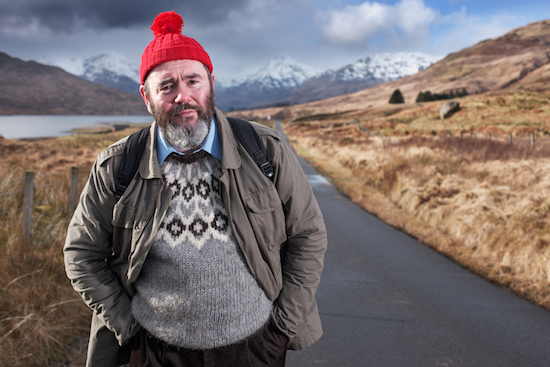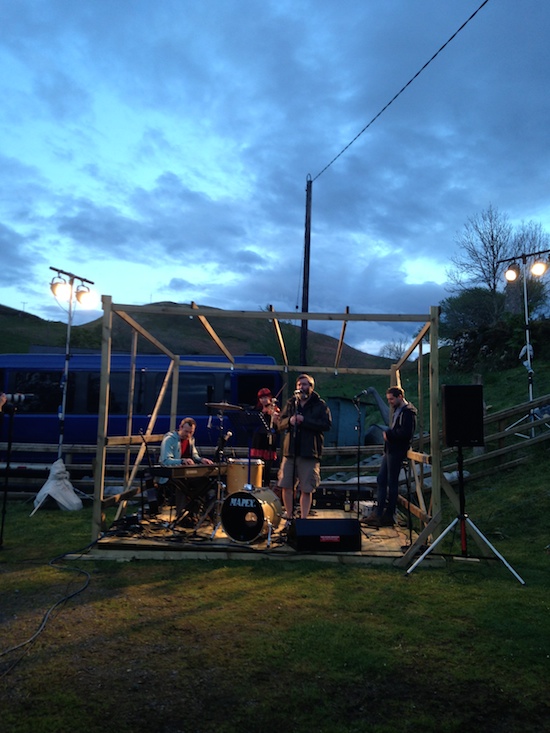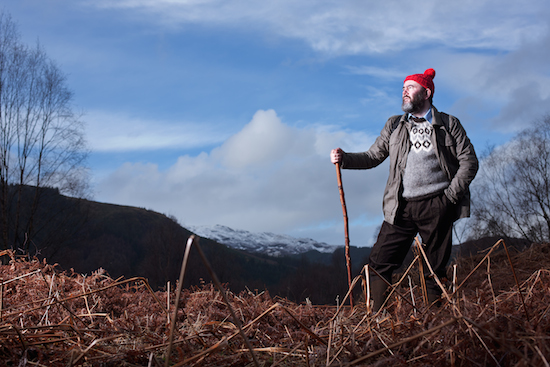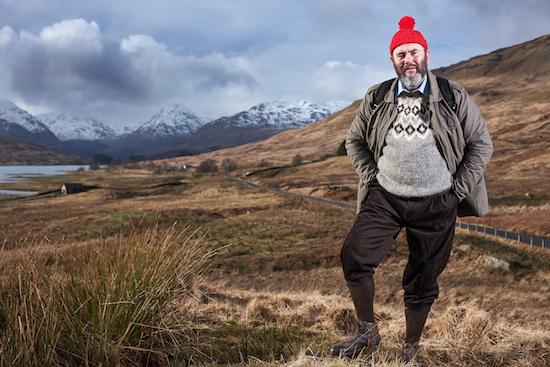So that was the first big weekend of the summer. Starts Friday as usual, stockpiling Pot Noodles, thermal g-strings and waterproof breeches, the better to weather a whisky-fired carousal into the hills of Scotland; to ogle as clan chief Aidan Moffat (re)animates our oral traditions – coaxing auld songs into new verses and places, sword-fighting and sailing along the way – as part of a musical road trip, and forthcoming feature-length film by Paul Fegan, called Where You’re Meant To Be.
Then on Saturday, we head for the Highlands.
Oban, that is. Specifically, two miles south into Lerags Glen – its farmland sound-tracked by lambs and new birds (“you remember that when she swung her arms, she held your hand”), its nearby crumbling Kilbride Churchyard providing the venue for the evening’s folk-pop frolics. The stage itself, a timber frame, only just houses ex-Arab Strap seducer Moffat and his majestic backing band – James Graham (The Twilight Sad), Jenny Reeve (Bdy_Prts) and Stevie Jones (Alasdair Roberts, Arab Strap). And the catering? Well, that’s courtesy of a gaggle in mediaeval garb, boiling gruel and carving neeps and and spit-roasting fowl over an open fire, with occasional jousting thrown in for good measure. Tomorrow, these people will do battle. Tomorrow, Moffat will become a warrior.
Tonight, though, he commands a set comprising a new body of work – a humorous and poignant series of 21st Century interpretations of traditional folk-songs that’s been honed on a Caledonian expedition. Thus far, Moffat, Fegan et al have busked, collaborated, gathered tales and gallivanted from Faslane Peace Camp to the Isle of Lewis; from the banks of Loch Ness to Edinburgh catacombs; from a boat on the Clyde (which launched the tour last month) to our twilit Oban churchyard. The tour will culminate at Glasgow Barrowland this weekend (at the time of writing, limited free tickets are still available at the link below), at a gig-come-ceilidh that stars, among others, Moffat and his merry troupe, plus championship bothy balladeers Geordie Murison and Joe Aitken, and travelling folk legend Sheila Stewart, whose mother, Belle, has a cardinal role in the project’s origins. As does Batman.

Their great Scottish (ad)venture has myriad recurring motifs, including spontaneity, communal frivolity, conjoining the ancient and the modern – and they’re all in rampant force in Lerags. It’s a post-gig ceilidh in the cowshed-pub; it’s moonwalking to Charles and Eddie’s nonpareil ‘Would I Lie To You’ on our farmhouse MTV at 3am. It’s Moffat, hungover, in ye olde costume, getting sword-fighting lessons on Sunday morning; it’s landowner Liam in a FREE PALESTINE t-shirt, cutting about our pseudo-medieval bivouac on a hi-tech quad-bike. It’s traditional board games piled up in the kitchen (Dingbats), and our modern renditions. (Strip Dingbats, anyone?)
It is Moffat, and Fegan creating a timely portrait of contemporary Scotland, informed by its places and histories and characters; its folklore and topography and language.
—
“And so that’s now where we are, we’re standing swaying by the bar, catching eyes and full of grog and glee / Jimmy gets a round and pays, raises a pint and proudly says, ‘you always come to where you’re meant to be.’” – ‘Where You’re Meant To Be’.
The title, Where You’re Meant To Be, speaks volumes – obviously in relation to the song from which it takes its name, but also in terms of the project in general, and its exploration of identity and sense of place. Did that title inform the rest of the work? It’s a tale in itself; a setting; a punchline.
Aidan Moffat: Aye, and it’s a question as well. That title just seemed to make sense for everything. The song’s about James [Graham], he’s the Jim in it. It started as an experiment to write a song about a night out we had, because I really wanted to use James’ voice, it’s a beautiful voice. In fact, I’ll tell you what it was – I’d got free tickets to a Batman live stage show at the SECC…
A stage show? What, like a Batman musical? That’s what’s at the heart of this?
AM: It was a Batman musical, aye. With acrobatics. [He laughs into his pint.] And I thought, there’s only one person that would go to that with me. It was James. We went on a pub crawl afterwards, so I used that as the basis of the song. It’s about Glasgow, fundamentally, and it’s about [infamous pub and Moffat’s spiritual home] Sleazy’s. We went to all these different places – we said, you know, we’ll try somewhere new – but it didn’t work out for us. We just ended up in the pub that we always go to.
We can all identify with that sentiment, that striving for a sense of belonging, or familiarity, and that’s a common trait in Paul’s work as a film-maker [his short film about pigeon-racing, Pouters, won countless awards], and yours as a songwriter and storyteller: it’s invested with meticulous local detail, and yet it has universal appeal.
AM: The songs that I write and I sing, on face value they seem very specific, but there’s no point in writing a song if it’s just about you, is there? That’s a waste of everybody’s time. There has to be a reason you want to discuss these things. And there has to be a reason that people want to hear them.

What attracted you to particular songs from the traditional folk canon? This is the first time you’ve reinterpreted existing works; how did you choose them?
AM: It was just about waiting for wee diamonds to poke out. I’m not quite sure what grabs my attention, so a lot of the time I’d just put a compilation of bothy ballads on in the background and wait for some wee nugget to poke out. [Bawdy sext-chorale] ‘I’m A Rover’ though, that was one we heard live in Kirriemuir. When we first started, Paul and I went to Kirriemuir, where they have a big folk festival. I’d never been there before – it was great seeing people who still have folk music as part of their everyday lives, there’s something much more genuine about that. I was standing at the back, one of the youngest folk there, in my trainers and indie clothes supping my cider, and Paul with his fancy camera. It was brilliant. When we were there, this guy Jim sang a version of ‘I’m A Rover’ which I really liked – it had this chorus about how it’s only when you’re pished that you want to get off with your girlfriend. [Laughs.] Things like that appeal to me. I decided to write it from the point of view of a sex pest.
In Oban, Moffat’s take on ‘I’m A Rover’ goes down particularly well. A woman in mediaeval dress picks horse-chestnut leaves in time to the music, while the rest of us sing along and share a bottle of whisky handed out by the band – none of your cheap stuff; it’s Aberfeldy single malt – vaguely distracted by a kilted man who’s moonwalking across the grass. (What is it with moonwalking round these parts?)
A lot of the subject matter in these songs isn’t so different from your work in Arab Strap or with Bill Wells – there’s a fair amount of sex and laughs.
AM: It actually started out quite serious, but now [gorgeous military lament] ‘Jock McGraw’s the only one that’s still quite serious. The rest of it’s a laugh. That’s the thing you find – most of these old traditional songs are hilarious, they’re all about getting pished and having a laugh and riding. And that’s what folk want to hear about. Shagging. That’s what keeps us alive.
You’ve known that for many years.
AM: Haha, well exactly. Aye.
I like the cyclical nature of the project: the idea of old songs being recycled; the way your plans for it have evolved [Where You’re Meant To Be was originally half-conceived as a Fegan-promoted Moffat spoken word mini-tour several years back]; the fact that Sheila Stewart has come out of retirement to perform with you, and that it was her mother who inspired this venture, in many ways.
AM: Belle Stewart, Sheila’s mum, kind of sparked the whole idea. I was listening to an album of her stuff, and that’s when I was starting to think more about the storytelling thing, because that’s what her songs do – and they’re quite often very simple melodies, so you have to concentrate. You have to hold people’s attention. I like that challenge. The melody for ‘Where You’re Meant To Be’ is one that Belle Stewart uses – she stole it from Harry Lauder.
Paul Fegan: Sheila Stewart just felt real, from the minute I read her biog. She’s one of those perennials, she kept coming up everywhere you looked, everything you heard. A lot of roads lead back to the Stewarts.
AM: It’s amazing to have Sheila – she’s pretty much the last surviving singer from that travelling folk tradition, there’s nobody else. And the Stewarts, her family, her mum and her father, were studied. I’ve got a book about her in the house that Ewan MacColl wrote, this was before they were doing a lot of recording, it’s got a history of the family, all the lyrics to all the songs. I’m sure it’s got the sheet music as well.

The idea of re-animating existing songs – of songs as living, evolving entities, rather than permanent recorded artefacts – resonates with #UNRAVEL, Aidan’s collaboration with FOUND, which saw their emotional robot band play different versions of the same record depending on audience, mood, and so on.
PF: Yeah, and also, with the songs for Where You’re Meant To Be, they aren’t professional as such – they’re fun, they’re irreverent, they’re more about the performance there and then, rather than the perfected recording of it. It’s about sharing songs and stories different audiences. The locations are a big part of the stories and songs too – not only their geography, but also the characters within that, and the journeys there, or the stories that link to it.
This tour (along with on-site set-pieces) will provide the groundwork for a feature-film, due to premiere after the Commonwealth Games in late August. There’s obviously a lot you can’t predict (the weather, the performances) so there’s a sense of letting the film find its own narrative to some extent – but do you have an overall aesthetic in mind?
AM: Paul and I went on a man-date to Sunshine on Leith. I enjoyed that because it’s great to see Scotland in a positive light, in any way. I much preferred that idea to Filth, because at least it was positive.
PF: And then of course you’ve got Under The Skin. Whereas the first two are filmed in Scotland, and their stories are based around Scotland, we both agreed that Under The Skin actually captures Scotland best, visually.
AM: The thing about Sunshine On Leith and Filth is, it’s the two polar opposites. It’s a shortbread tin, or a cesspit of violence and bigotry. I think the idea is to approach it from a middle ground. It’s about trying to maintain a neutral eye, if that’s possible. I actually came out of Filth angry – I’m sick of seeing Scotland like that. Get yourself to fuck, that’s boring – especially now, in this year, when we’re supposed to be discussing the future of Scotland. Everything about Filth was a stereotype, it’s got the fat family eating chips, and drinking Irn Bru. It really offended me. I’ve no idea why someone would want to portray Scotland that way in the 21st Century. I think it’s always been on my mind, when we knew there was going to be a film of this, which was before I wrote a lot of the songs. I was thinking, I don’t want Scotland to be seen as this miserable place. It’s a beautiful country. And it’s a hilarious country.
—
Back in Oban, Moffat winds up the evening’s gig with an orgiastic hillside anthem (‘The Ball of Kirriemuir’) as the sun goes down; sings songs from yesterday on the cusp of tomorrow; breathes new life and light into age-old scenarios. Two children break ranks and dance round a tombstone. Everything’s getting younger.
Aidan Moffat will be live at Barrowland, Glasgow, May 17 – free tickets are available via here; the film will premiere in late August, as part of Glasgow 2014’s Cultural Programme.


